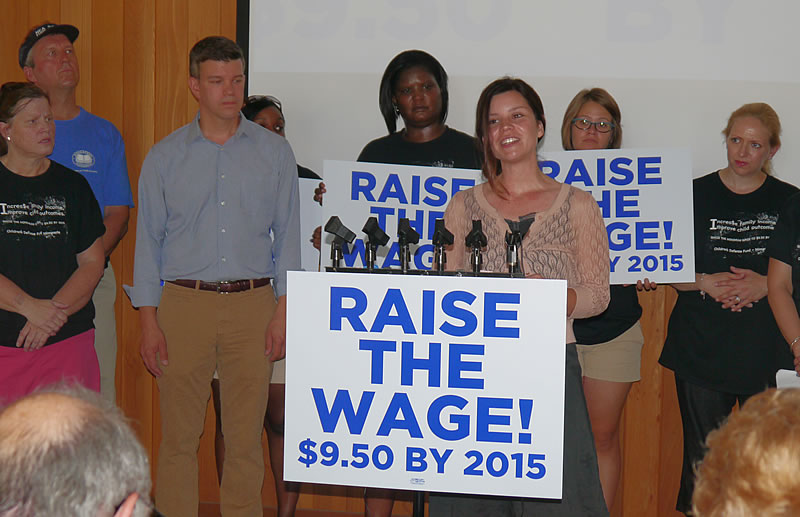

Share
A $9.50 an hour Minnesota minimum wage would help working families and working adults pay for basic needs, according to an upcoming report by Jobs Now Coalition in Saint Paul. The report looks at Minnesota workers whose wages are below $9.50 as well as those slightly above, who would see a raise due to what economists call the “spillover effect.”
Out of a total of 357,000 Minnesota workers across the demographic spectrum who would see a raise, about 77 percent are age 20 or older. And 33 percent are married or are parents.
“The economic security of families is critical to the health and well-being of our children,” says Peggy Flanagan, executive director of Children’s Defense Fund Minnesota.
The report shows that some 137,000 children in Minnesota would benefit from increased parental income if the state minimum wage were increased to $9.50 an hour.
Parental income matters for children’s academic success and future prospects. A 2011 report by Julia Isaacs of the Brookings Institution Center on Children and Families shows that an additional $1,000 of average income throughout early childhood can result in higher reading and math scores for children in low-income families.
Rev. Alison Killeen, who ministers at First Congregational Church of Minnesota, sees wages as a moral as well as practical issue. “God calls us to treat one another with dignity and equity,” says Killeen. “Increasing pay for those at the bottom of the pay scale would be an investment in workers’ dignity and would help families not only survive, but to thrive.”
But job seekers in Minnesota, including adults who are raising a family or who hope to build savings to raise a family, face a job market in which a significant share of openings offer low wages, according to the latest Job Vacancy Survey by Minnesota’s Department of Employment and Economic Development.
Only 42 percent of all Minnesota job openings require education beyond high school, and 45 percent of all openings are part-time. The median wage for all part-time openings is $9.00 per hour and for food preparation and serving openings is $7.50 per hour.
Low wage jobs like these can constitute a significant share of family income. If minimum wage were $9.50 an hour, among parents who would get a raise, this wage is 52 percent of family income, on average. And for 23 percent of parents who would get a raise, their wage is the sole source, or 100 percent, of family income.
Flanagan of Children’s Defense Fund notes that many low-wage parents must work multiple jobs to meet basic needs. “Child care costs consume a significant part of a family’s income,” says Flanagan, who adds that in St. Louis County, for example, licensed child care costs over $6,000 per year. Research by Jobs Now Coalition shows that the cost is even higher in the Twin Cities Metro—about $8,000 per year for one child.
That’s a big chunk out of $15,080 a year for a full-time worker at today’s effective minimum wage of $7.25 an hour.
Derah Garth, a working mother in Saint Paul, knows the challenge firsthand. She works two part-time jobs to try to make ends meet, but still can’t afford childcare. “Every week my schedule is different, which means that every week my daughter’s schedule is different,” says Garth. “My daughter often does not know where she will be sleeping each night, because when I get called into work, I need to find a family member who can take care of her on short notice.”
“As a mother, to call living on minimum wage difficult is an understatement, it’s really a struggle to survive,” says Garth.
The proposed new wage of $9.50 an hour would yield $19,760 a year for a full-time worker and would mean a raise for about 63,000 parents in Minnesota.
If the federal minimum wage had maintained it’s purchasing power since 1968, it would today be over $10.70 an hour, or $22,256 a year for a full-time worker, according to the U.S. Bureau of Labor Statistics. If minimum wage had kept pace with average productivity gains, as it did in the decades leading up to the 1960s, it would today be about $22.00 an hour.
The Minnesota Legislature is expected to take up the $9.50 an hour minimum wage bill in the first weeks of the 2014 legislative session. Some 137,000 children—about one in every ten children in Minnesota—would benefit if the state raised the minimum wage to $9.50 an hour.
“When you increase family income, you improve child outcomes” Flanagan explains, “and by improving child development outcomes, we are helping to ensure a prosperous future for Minnesota. Increasing the minimum wage to $9.50 an hour is a first step.”
This article is reprinted from Minnesota 2020.

